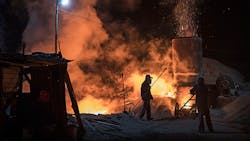China’s Steel Capacity Grows in 2016 Despite Pledges
BEIJING — China increased its steelmaking capacity last year, according to a report published Monday, despite repeated pledges to cut huge excess in the sector.
China makes more than half the world’s steel, but a slowdown in its economy and sagging global demand has left the industry with massive excess capacity. It has been accused of dumping its production on world markets, depressing prices and violating international trade agreements.
Throughout 2016, authorities vowed to tackle excess production through consolidation and shutting idle or inefficient factories. But while some steel capacity was cut, this was more than offset by China’s opening of new factories or restarting of idle plants, according to a report by steel consultancy Custeel and Greenpeace East Asia.
It said China’s operating steelmaking capacity increased by 36.5 million tonnes in 2016 — more than twice as much as the total production capacity of Britain. About 80% of this increase occurred in three provinces bordering Beijing, causing air pollution to spike in the capital at the end of the year and early 2017, it added.
Steelmaking is the country’s second-largest emitter of air pollution, the report said.
Nearly three-quarters of plants affected by China’s capacity cuts in 2016 were already idle.
Instead of shutting down firms, local officials maneuvered to “shield zombie steel mills and minimize the impact of the policies” on cutting capacity, said Lauri Myllyvirta, Greenpeace global coal campaigner.
Despite an agreement for Beijing to address steel overcapacity reached at September’s G20 meeting in Hangzhou, China’s trade partners have accused it of dumping the metal on markets in violation of trade rules.
Earlier this month, the U.S. Department of Commerce imposed hefty tariffs on certain Chinese steel imports, with duties ranging from 63% to 190% on Chinese exporters accused of selling their products at below fair value or of being unfairly subsidized.
In January, the European Union unveiled taxes of between 30.7% and 64.9% on certain Chinese steel products as it seeks to protect struggling steelmakers in Europe.
China must target cuts on operating steel factories and not on idle ones, the Custeel report said, noting that more than 20 million tonnes of new capacity is already due to come online.
Factories should be demolished and not sealed up to prevent their reopening in the future, it said.
Copyright Agence France-Presse, 2017
About the Author
Agence France-Presse
Copyright Agence France-Presse, 2002-2025. AFP text, photos, graphics and logos shall not be reproduced, published, broadcast, rewritten for broadcast or publication or redistributed directly or indirectly in any medium. AFP shall not be held liable for any delays, inaccuracies, errors or omissions in any AFP content, or for any actions taken in consequence.
